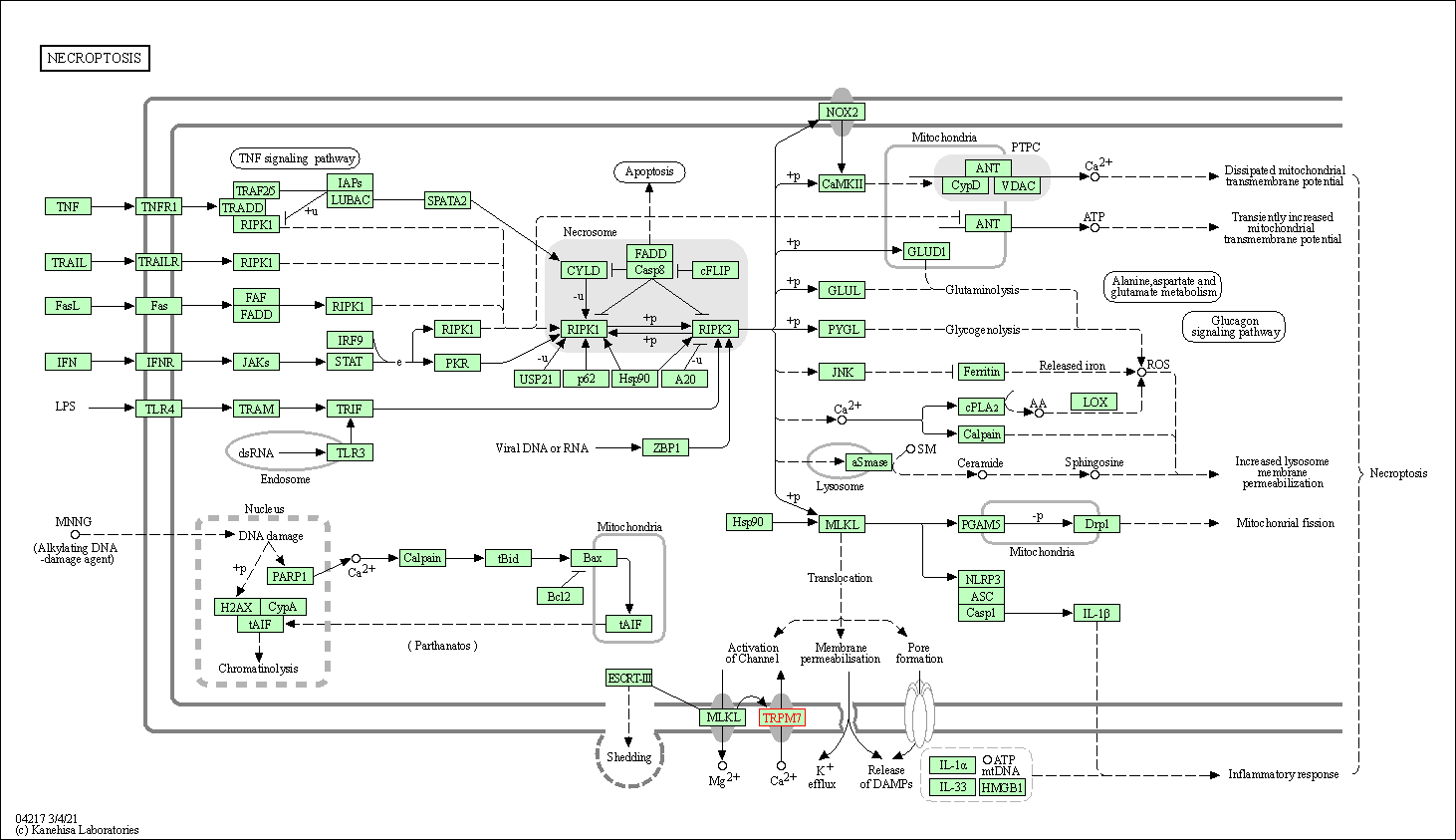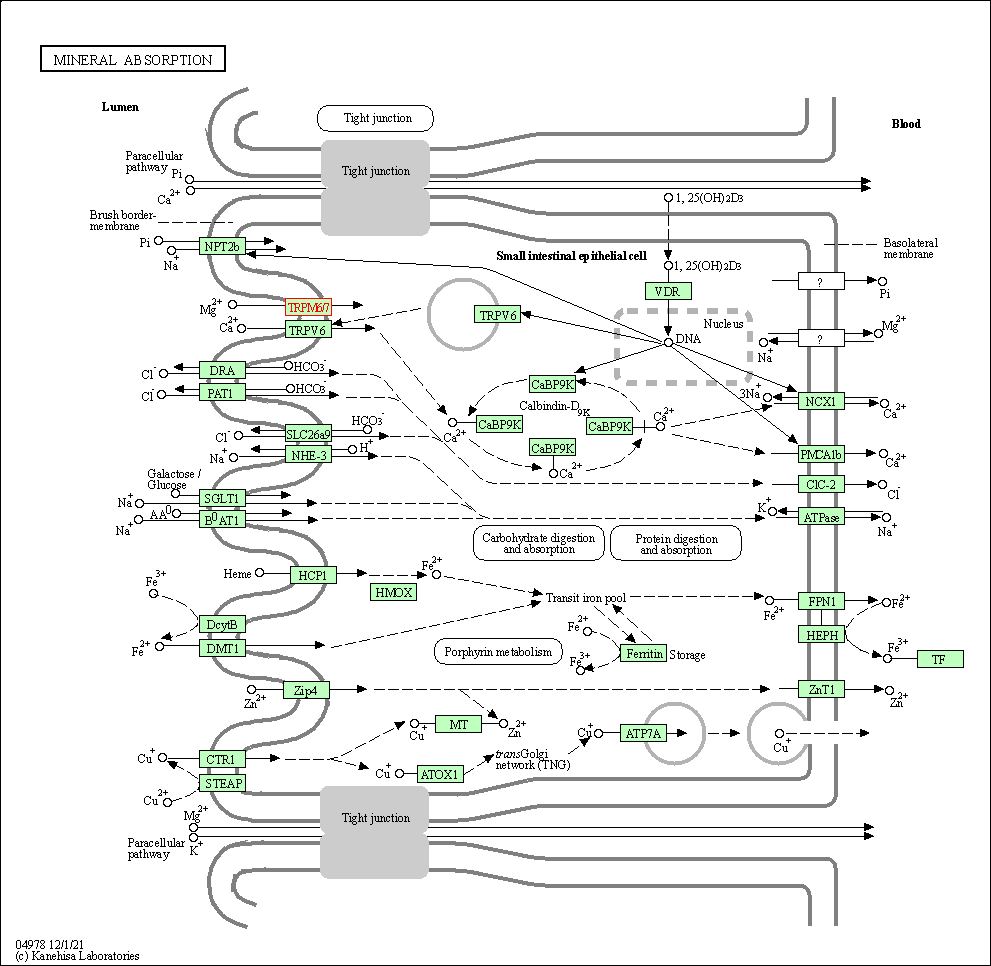Target Information
| Target General Information | Top | |||||
|---|---|---|---|---|---|---|
| Target ID |
T11906
(Former ID: TTDI03597)
|
|||||
| Target Name |
Long transient receptor potential channel 7 (TRPM7)
|
|||||
| Synonyms |
Transient receptor potential cation channel subfamily M member 7; LTrpC-7; LTRPC7; Channel-kinase 1; CHAK1
Click to Show/Hide
|
|||||
| Gene Name |
TRPM7
|
|||||
| Target Type |
Literature-reported target
|
[1] | ||||
| Function |
Essential ion channel and serine/threonine-protein kinase. Divalent cation channel permeable to calcium and magnesium. Has a central role in magnesium ion homeostasis and in the regulation of anoxic neuronal cell death. Involved in TNF-induced necroptosis downstream of MLKL by mediating calcium influx. The kinase activity is essential for the channel function. May be involved in a fundamental process that adjusts plasma membrane divalent cation fluxes according to the metabolic state of the cell. Phosphorylates annexin A1 (ANXA1).
Click to Show/Hide
|
|||||
| BioChemical Class |
Transient receptor potential catioin channel
|
|||||
| UniProt ID | ||||||
| EC Number |
EC 2.7.11.1
|
|||||
| Sequence |
MSQKSWIESTLTKRECVYIIPSSKDPHRCLPGCQICQQLVRCFCGRLVKQHACFTASLAM
KYSDVKLGDHFNQAIEEWSVEKHTEQSPTDAYGVINFQGGSHSYRAKYVRLSYDTKPEVI LQLLLKEWQMELPKLVISVHGGMQKFELHPRIKQLLGKGLIKAAVTTGAWILTGGVNTGV AKHVGDALKEHASRSSRKICTIGIAPWGVIENRNDLVGRDVVAPYQTLLNPLSKLNVLNN LHSHFILVDDGTVGKYGAEVRLRRELEKTINQQRIHARIGQGVPVVALIFEGGPNVILTV LEYLQESPPVPVVVCEGTGRAADLLAYIHKQTEEGGNLPDAAEPDIISTIKKTFNFGQNE ALHLFQTLMECMKRKELITVFHIGSDEHQDIDVAILTALLKGTNASAFDQLILTLAWDRV DIAKNHVFVYGQQWLVGSLEQAMLDALVMDRVAFVKLLIENGVSMHKFLTIPRLEELYNT KQGPTNPMLFHLVRDVKQGNLPPGYKITLIDIGLVIEYLMGGTYRCTYTRKRFRLIYNSL GGNNRRSGRNTSSSTPQLRKSHESFGNRADKKEKMRHNHFIKTAQPYRPKIDTVMEEGKK KRTKDEIVDIDDPETKRFPYPLNELLIWACLMKRQVMARFLWQHGEESMAKALVACKIYR SMAYEAKQSDLVDDTSEELKQYSNDFGQLAVELLEQSFRQDETMAMKLLTYELKNWSNST CLKLAVSSRLRPFVAHTCTQMLLSDMWMGRLNMRKNSWYKVILSILVPPAILLLEYKTKA EMSHIPQSQDAHQMTMDDSENNFQNITEEIPMEVFKEVRILDSNEGKNEMEIQMKSKKLP ITRKFYAFYHAPIVKFWFNTLAYLGFLMLYTFVVLVQMEQLPSVQEWIVIAYIFTYAIEK VREIFMSEAGKVNQKIKVWFSDYFNISDTIAIISFFIGFGLRFGAKWNFANAYDNHVFVA GRLIYCLNIIFWYVRLLDFLAVNQQAGPYVMMIGKMVANMFYIVVIMALVLLSFGVPRKA ILYPHEAPSWTLAKDIVFHPYWMIFGEVYAYEIDVCANDSVIPQICGPGTWLTPFLQAVY LFVQYIIMVNLLIAFFNNVYLQVKAISNIVWKYQRYHFIMAYHEKPVLPPPLIILSHIVS LFCCICKRRKKDKTSDGPKLFLTEEDQKKLHDFEEQCVEMYFNEKDDKFHSGSEERIRVT FERVEQMCIQIKEVGDRVNYIKRSLQSLDSQIGHLQDLSALTVDTLKTLTAQKASEASKV HNEITRELSISKHLAQNLIDDGPVRPSVWKKHGVVNTLSSSLPQGDLESNNPFHCNILMK DDKDPQCNIFGQDLPAVPQRKEFNFPEAGSSSGALFPSAVSPPELRQRLHGVELLKIFNK NQKLGSSSTSIPHLSSPPTKFFVSTPSQPSCKSHLETGTKDQETVCSKATEGDNTEFGAF VGHRDSMDLQRFKETSNKIKILSNNNTSENTLKRVSSLAGFTDCHRTSIPVHSKQAEKIS RRPSTEDTHEVDSKAALIPDWLQDRPSNREMPSEEGTLNGLTSPFKPAMDTNYYYSAVER NNLMRLSQSIPFTPVPPRGEPVTVYRLEESSPNILNNSMSSWSQLGLCAKIEFLSKEEMG GGLRRAVKVQCTWSEHDILKSGHLYIIKSFLPEVVNTWSSIYKEDTVLHLCLREIQQQRA AQKLTFAFNQMKPKSIPYSPRFLEVFLLYCHSAGQWFAVEECMTGEFRKYNNNNGDEIIP TNTLEEIMLAFSHWTYEYTRGELLVLDLQGVGENLTDPSVIKAEEKRSCDMVFGPANLGE DAIKNFRAKHHCNSCCRKLKLPDLKRNDYTPDKIIFPQDEPSDLNLQPGNSTKESESTNS VRLML Click to Show/Hide
|
|||||
| 3D Structure | Click to Show 3D Structure of This Target | AlphaFold | ||||
| HIT2.0 ID | T48J2C | |||||
| Cell-based Target Expression Variations | Top | |||||
|---|---|---|---|---|---|---|
| Cell-based Target Expression Variations | ||||||
| Different Human System Profiles of Target | Top |
|---|---|
|
Human Similarity Proteins
of target is determined by comparing the sequence similarity of all human proteins with the target based on BLAST. The similarity proteins for a target are defined as the proteins with E-value < 0.005 and outside the protein families of the target.
A target that has fewer human similarity proteins outside its family is commonly regarded to possess a greater capacity to avoid undesired interactions and thus increase the possibility of finding successful drugs
(Brief Bioinform, 21: 649-662, 2020).
Human Tissue Distribution
of target is determined from a proteomics study that quantified more than 12,000 genes across 32 normal human tissues. Tissue Specificity (TS) score was used to define the enrichment of target across tissues.
The distribution of targets among different tissues or organs need to be taken into consideration when assessing the target druggability, as it is generally accepted that the wider the target distribution, the greater the concern over potential adverse effects
(Nat Rev Drug Discov, 20: 64-81, 2021).
Human Pathway Affiliation
of target is determined by the life-essential pathways provided on KEGG database. The target-affiliated pathways were defined based on the following two criteria (a) the pathways of the studied target should be life-essential for both healthy individuals and patients, and (b) the studied target should occupy an upstream position in the pathways and therefore had the ability to regulate biological function.
Targets involved in a fewer pathways have greater likelihood to be successfully developed, while those associated with more human pathways increase the chance of undesirable interferences with other human processes
(Pharmacol Rev, 58: 259-279, 2006).
Biological Network Descriptors
of target is determined based on a human protein-protein interactions (PPI) network consisting of 9,309 proteins and 52,713 PPIs, which were with a high confidence score of ≥ 0.95 collected from STRING database.
The network properties of targets based on protein-protein interactions (PPIs) have been widely adopted for the assessment of target’s druggability. Proteins with high node degree tend to have a high impact on network function through multiple interactions, while proteins with high betweenness centrality are regarded to be central for communication in interaction networks and regulate the flow of signaling information
(Front Pharmacol, 9, 1245, 2018;
Curr Opin Struct Biol. 44:134-142, 2017).
Human Similarity Proteins
Human Tissue Distribution
Human Pathway Affiliation
Biological Network Descriptors
|
|
|
There is no similarity protein (E value < 0.005) for this target
|
|
Note:
If a protein has TS (tissue specficity) scores at least in one tissue >= 2.5, this protein is called tissue-enriched (including tissue-enriched-but-not-specific and tissue-specific). In the plots, the vertical lines are at thresholds 2.5 and 4.
|




| KEGG Pathway | Pathway ID | Affiliated Target | Pathway Map |
|---|---|---|---|
| Necroptosis | hsa04217 | Affiliated Target |

|
| Class: Cellular Processes => Cell growth and death | Pathway Hierarchy | ||
| Cellular senescence | hsa04218 | Affiliated Target |

|
| Class: Cellular Processes => Cell growth and death | Pathway Hierarchy | ||
| NOD-like receptor signaling pathway | hsa04621 | Affiliated Target |

|
| Class: Organismal Systems => Immune system | Pathway Hierarchy | ||
| Mineral absorption | hsa04978 | Affiliated Target |

|
| Class: Organismal Systems => Digestive system | Pathway Hierarchy | ||
| Degree | 1 | Degree centrality | 1.07E-04 | Betweenness centrality | 0.00E+00 |
|---|---|---|---|---|---|
| Closeness centrality | 1.07E-04 | Radiality | 3.98E-03 | Clustering coefficient | 0.00E+00 |
| Neighborhood connectivity | 1.00E+00 | Topological coefficient | . | Eccentricity | 1 |
| Download | Click to Download the Full PPI Network of This Target | ||||
| Drug Property Profile of Target | Top | |
|---|---|---|
| (1) Molecular Weight (mw) based Drug Clustering | (2) Octanol/Water Partition Coefficient (xlogp) based Drug Clustering | |
|
|
||
| (3) Hydrogen Bond Donor Count (hbonddonor) based Drug Clustering | (4) Hydrogen Bond Acceptor Count (hbondacc) based Drug Clustering | |
|
|
||
| (5) Rotatable Bond Count (rotbonds) based Drug Clustering | (6) Topological Polar Surface Area (polararea) based Drug Clustering | |
|
|
||
| "RO5" indicates the cutoff set by lipinski's rule of five; "D123AB" colored in GREEN denotes the no violation of any cutoff in lipinski's rule of five; "D123AB" colored in PURPLE refers to the violation of only one cutoff in lipinski's rule of five; "D123AB" colored in BLACK represents the violation of more than one cutoffs in lipinski's rule of five | ||
| References | Top | |||||
|---|---|---|---|---|---|---|
| REF 1 | The TRPM7 channel is inactivated by PIP(2) hydrolysis. Nat Cell Biol. 2002 May;4(5):329-36. | |||||
| REF 2 | LTRPC7 is a Mg.ATP-regulated divalent cation channel required for cell viability. Nature. 2001 May 31;411(6837):590-5. | |||||
| REF 3 | Carvacrol is a novel inhibitor of Drosophila TRPL and mammalian TRPM7 channels. Cell Calcium. 2009 Mar;45(3):300-9. | |||||
| REF 4 | Waixenicin A inhibits cell proliferation through magnesium-dependent block of transient receptor potential melastatin 7 (TRPM7) channels. J Biol Chem. 2011 Nov 11;286(45):39328-35. | |||||
If You Find Any Error in Data or Bug in Web Service, Please Kindly Report It to Dr. Zhou and Dr. Zhang.

